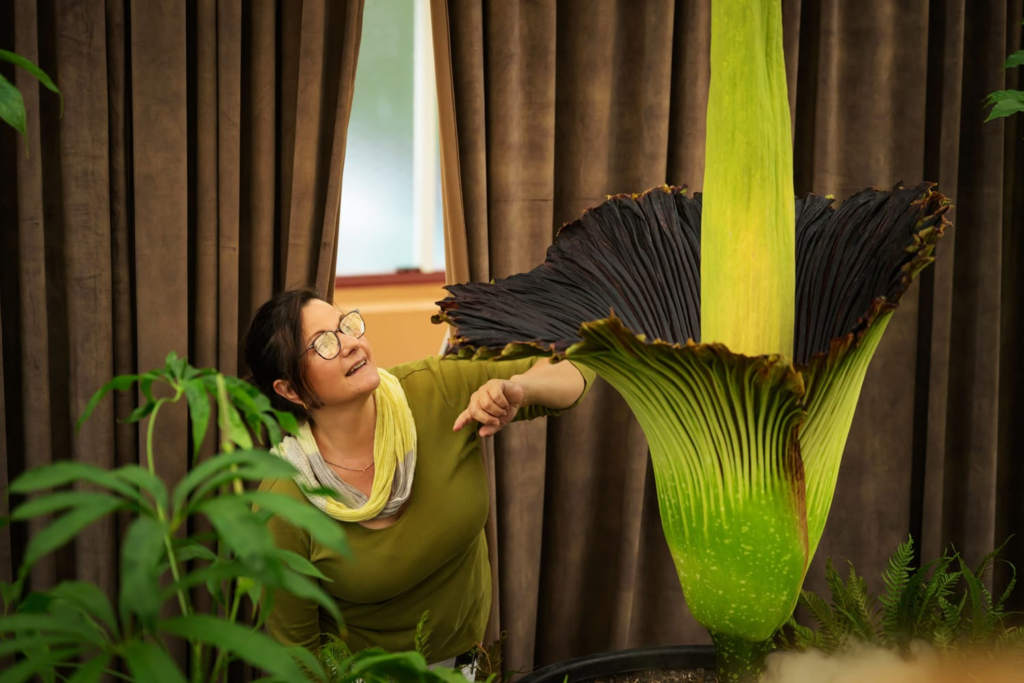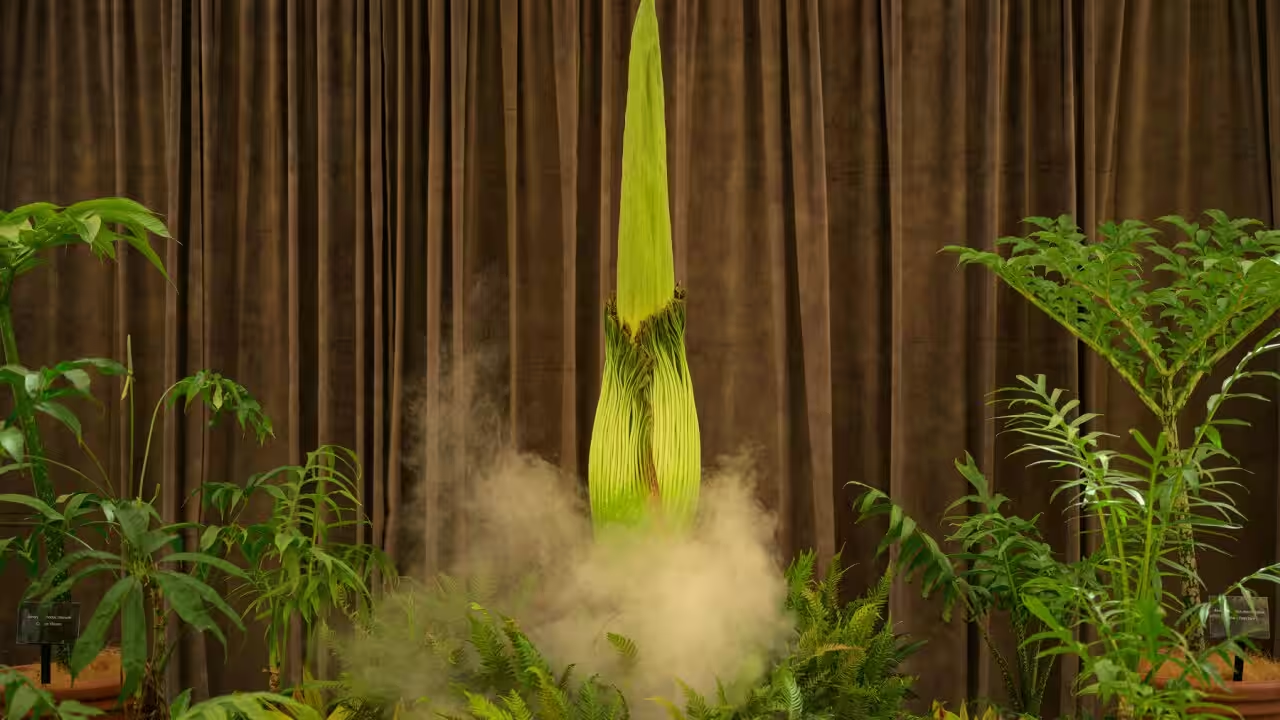A rare and fascinating botanical phenomenon has drawn thousands of visitors to Sydney’s Royal Botanic Gardens. “Putricia,” the internet-famous corpse flower, has become a sensation, offering onlookers a chance to witness its massive bloom and infamous stench.
This captivating event has spotlighted the unique allure of one of nature’s most peculiar plants, blending science, curiosity, and social media excitement.
The Rare Bloom of Putricia
The corpse flower, scientifically named Amorphophallus titanum and nicknamed “bunga bangkai” in its native Indonesia, is famous for its enormous size and pungent odor.
In the wild, it can grow up to three meters tall, with crimson, fluted petals spanning more than a meter in diameter. Putricia, the latest addition to Sydney’s Royal Botanic Gardens collection of 11 corpse flowers, reached an impressive height of 1.6 meters during this bloom.
The bloom itself is a rare occurrence. The Titan Arum typically flowers only once every three to five years, and each bloom lasts a mere 48 hours. Before Putricia, the last corpse flower bloom in Sydney was over a decade ago in 2010.
Read : Rare Corpse Flower Blooms in Geelong Botanic Garden in Australia
This rarity, combined with the plant’s reputation for emitting a stench resembling rotting flesh, has made its blooming events global attractions.
WATCH: Known for its smell of putrid, rotting flesh, a Corpse Flower bloomed for the first time in 15 years at the Royal Botanic Garden in Sydney, Australia on Thursday.
— Globalnews.ca (@globalnews) January 23, 2025
Read more: https://t.co/PMr5MditOd pic.twitter.com/DQynCv47I6
Putricia’s scent, often described as “dead rat” or “hot rubbish,” plays a crucial role in its reproductive strategy. The plant generates heat, which triggers chemical reactions that produce its powerful odor, mimicking decaying organic matter.
This smell attracts pollinators like flies and beetles, essential for the plant’s survival in its natural habitat. Sydney Botanic Gardens chief scientist, Professor Brett Summerell, described the process as a “build-up,” with the scent reaching its peak as the flower unfurls.
A Viral Sensation: The Story of Putricia
What sets Putricia apart from other corpse flowers is her newfound internet fame. Over the course of 18 days, the Royal Botanic Gardens documented her growth from a small bud to a towering bloom through a dedicated livestream.
This online effort garnered more than 1.5 million views and sparked lively discussions in an active Discord community, connecting plant enthusiasts and curious viewers worldwide.
John Siemon, director of horticulture and living collections at the gardens, expressed amazement at the public’s overwhelming interest. Over 20,000 visitors flocked to the gardens during the week of Putricia’s bloom, some waiting in line for hours to witness the spectacle.
Among them was Sydney resident Rebecca McGee-Collett, who described the flower as visually stunning but humorously likened the smell to “hot garbage.”

Putricia’s blooming was not just a local sensation but a global event. Social media platforms like TikTok amplified the plant’s popularity, as videos of the crowds and reactions to the flower’s infamous scent spread rapidly.
The Royal Botanic Gardens staff, who nicknamed her “Putricia” as a playful nod to her “putrid” smell, were thrilled by the widespread engagement and the plant’s newfound status as an influencer.
Conservation and the Future of Titan Arum
While Putricia’s bloom captivated audiences, it also highlighted the fragile state of the Titan Arum in the wild. Native to the Indonesian island of Sumatra, the corpse flower faces threats from habitat loss and poaching.
The plant is listed as endangered, with only 300 to 500 specimens estimated to remain in the wild. Efforts to conserve and propagate the species are critical to its survival.
At the Royal Botanic Gardens, staff are working diligently to preserve and propagate their collection of corpse flowers. This involves collecting pollen, monitoring growth cycles, and creating optimal conditions for future blooms.
The gardens hope to raise awareness about the plant’s conservation needs through public events like Putricia’s bloom, using the spectacle to educate visitors about the importance of protecting endangered species.

Despite its rarity, the Titan Arum plays a significant role in its ecosystem. By attracting specific pollinators, it ensures the continuation of its unique genetic lineage. Events like Putricia’s bloom not only provide a rare opportunity to witness this process but also serve as a reminder of the delicate balance between humanity and nature.
Putricia’s spectacular bloom at Sydney’s Royal Botanic Gardens has offered a unique blend of science, wonder, and humor. Thousands of visitors, both in-person and online, were drawn to witness the extraordinary flower and its infamous smell.
Beyond the spectacle, the event shed light on the importance of conservation efforts for endangered species like the Titan Arum.
As Putricia’s bloom comes to an end, her story serves as a testament to the power of nature to captivate and educate. The plant’s fleeting moment of glory not only delighted audiences but also underscored the urgent need to protect the natural world.
For those who waited patiently in line or followed her journey online, Putricia’s bloom was an unforgettable experience that celebrated the beauty and strangeness of our planet’s biodiversity.

